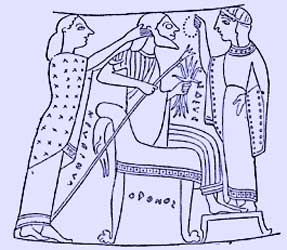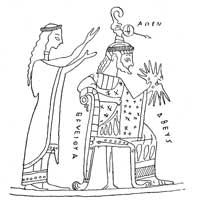.

Zeus and Eileithyia (or even two Eileithyiai)
Ilithyia—the Latin spelling—or more usually Eileithyia, was the Cretan goddess whom Greek mythology adapted as the goddess of childbirth and midwiving, and whom the relentlessly patrilineal Hesiod even described as a daughter of Zeus and Hera (Theogony 921)—and Apollodorus and Diodorus Siculus (5.72.5) agreed. But Pausanias reported another early source (now lost): "The Lycian Olen, an earlier poet, who composed for the Delians, among other hymns, one to Eileithyia, styles her 'the clever spinner', clearly identifying her with fate, and makes her older than Cronos.” (Description of Greece 8.21.3). Pindar, a meticulously accurate mythographer, likewise makes no mention of Zeus:
Goddess of childbirth, Eileithyia, maid to the throne of the deep-thinking Moirai, child of all-powerful Hera, hear my song. —Seventh Nemean Ode.
For the Classical Greeks, "She is closely associated with Artemis and Hera," Burkert asserts (1985, p 1761) "but develops no character of her own." In the Orphic Hymn to Prothyraia, the association of a goddess of childbirth as an epithet of virginal Artemis, making the death-dealing huntress also "she who comes to the aid of women in childbirth," (Graves 1955 15.a.1), would be inexplicable in purely Olympian terms:
When racked with labour pangs, and sore distressed
the sex invoke thee, as the soul’s sure rest;
for thou Eileithyia alone canst give relief to pain,
which art attempts to ease, but tries in vain.
Artemis Eileithyia, venerable power,
who bringest relief in labour’s dreadful hour.” —Orphic Hymn 2, to Prothyraia
Thus Aelian in the 3rd century AD could refer to "Artemis of the child-bed" (On Animals 7.15)
Homer Iliad pictures Eileithyia alone, or sometimes multiplied, as the Eileithyiai:
" Just as a sharp spasm seizes women giving birth,
a piercing labour pain sent by the Eilithyiae,
Hera's daughters, who control keen pangs of childbirth.” —Iliad XI.270.
Vase-painters illustrating the birth of Athena from Zeus' head may show two assisting Eileithyiai, with their hands raised in the epiphany gesture.
The cave of Eileithyia near Amnisos, the harbor of Knossos, which the Odyssey (xix.198) mentions in connection with her cult, was accounted the birthplace of Eileithyia. It has stalactites suggestive of the goddess' double form (Kerenyi 1976 fig. 6), of bringing labor on and of delaying it, and votive offerings to her have been found. Here she was probably being worshipped before Zeus arrived in the Aegean, but certainly in Minoan-Mycenaean times (Burkert 1985 p 171). The goddess is mentioned as Eleuthia in a Linear B fragment from Knossos [1] (http://www.pantheon.org/articles/e/eileithyia.html). In Classical times there were shrines to Eileithyia in the Cretan cities of Lato and Eleutherna and a sacred cave at Inatos. On the Greek mainland, at Olympia, an archaic shrine with an inner cella sacred to the serpent-savior of the city (Sosipolis) and to Eileithyia was seen by the traveller Pausanias in the 2nd century AD (Greece vi.20.1-3); in it a virgin-priestess cared for a serpent that was fed on honeyed barley-cakes and water. The shrine memorialized the appearance of a crone with a babe in arms, at a crucial moment when Elians were threatened by forces from Arcadia. The child, placed on the ground between the contending forces, changed into a serpent, driving the Arcadians away in flight, before it disappeared into the hill. There were ancient icons of Eileithyia at Athens, one said to have been brought from Crete, according to Pausanias, who mentioned shrines to Ilithyia in Tenea and Argos, with an extremely important shrine in Aigion. Ilithyia, along with Artemis and Persephone, is often shown carrying torches to bring children out of darkness and into light: in Roman mythology her counterpart in easing labor is 'Lucina ("of the light").
Such is the account I heard of the Asopus. When you have turned from the Acrocorinthus into the mountain road you see the Teneatic gate and a sanctuary of Eilethyia. [Pausanias 2.5.4]
In Greek shrines, small, terracotta votive figures (kourotrophos) depicted an immortal nurse who took care of divine infants, who may be connected with Eileithyia.
According to the Homeric Hymn III to Delian Apollo, Hera detained Eileithyia, who was coming from the Hyperboreans in the far north, to prevent Leto from going into labor with Artemis and Apollo, because the father was Zeus. The other goddesses present at the birthing on Delos sent Iris to bring her. As she stepped upon the island, the birth began.
She was especially worshipped in Crete, in the cities Lato and Eleuthernia. Caves were believed to be sacred to her (perhaps a reference to the birth canal). In Amnisos, a stalagmite in one cave was probably an icon of Ilithyia.
Alternative: Eilithia, Eilythia, Ilithia, Eileithyia, Eileithyiai, Eleuthia (Cretan dialect)
Links
- Theoi.com "Eileithyia" collects many classical references that have been used in this article.
References
Greek Religion, Walter Burkert
The Greek Myths: The Complete And Definitive Edition, Robert Graves
Dionysos: Archetypal Image of Indestructible Life, Carl Kerenyi
The Odyssey, Homer , Robert Fagles (Translator), Bernard MacGregor Walke Knox (Introduction)
See also : Greek Mythology. Paintings, Drawings
| Ancient Greece
Science, Technology , Medicine , Warfare, , Biographies , Life , Cities/Places/Maps , Arts , Literature , Philosophy ,Olympics, Mythology , History , Images Medieval Greece / Byzantine Empire Science, Technology, Arts, , Warfare , Literature, Biographies, Icons, History Modern Greece Cities, Islands, Regions, Fauna/Flora ,Biographies , History , Warfare, Science/Technology, Literature, Music , Arts , Film/Actors , Sport , Fashion --- |
Retrieved from "http://en.wikipedia.org"
All text is available under the terms of the GNU Free Documentation License


